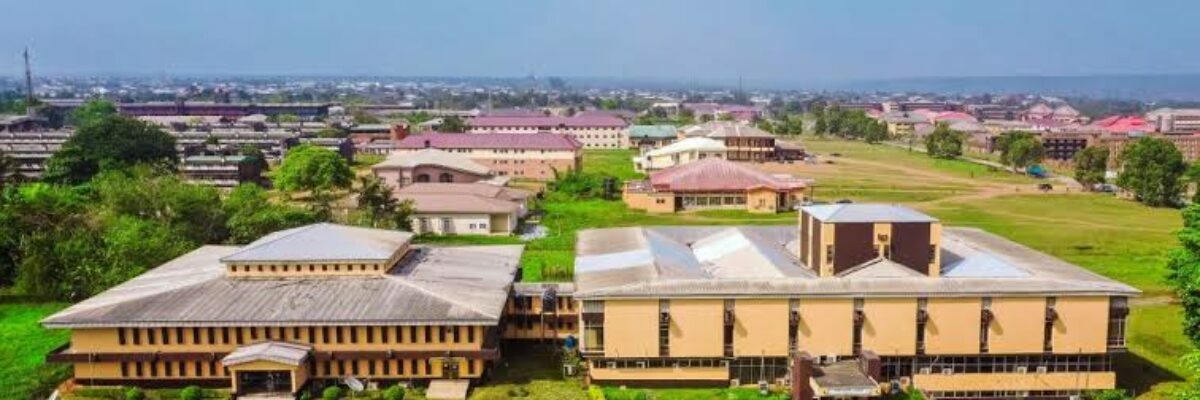The University of Benin Library known as John Harris Library is an academic resource centre established to cater for the research, learning and teaching needs of the academic community. Since its inception in 1970, the Library has grown in leaps and bounds in response to new developments in information science and technology and other developments in the University. John Harris Library is situated at Ugbowo Campus along the main drive between the students’ complex popularly called “Basement”, and the students’ Halls of Residence. It also stands directly opposite the Clinical Students Hostel, popularly called “Medical Hostel”.
The John Harris Library building has three levels namely:
- The Basement
- The Ground Floor and
- The First Floor
The Basement houses the Bindery, the Reprography, the Audio-Visual Section, the Archival Section, and the Canteen.The Security Post, Journal Unit, Waiting Area, Readers’ Conveniences, Checkpoint, Catalogue Cabinets, Online Public Access Catalogue (OPAC) points, Reference Desk (Ask-a-Librarian), Reference Section, Circulation Section, Acquisitions Section, Serials Section, Cataloguing and Classification Section (Workroom), and the administrative offices are all located on the Ground floor. While the Open Shelves, Special Collections Section, Reserved Unit, popularly called Textbook Collection Unit or TC, Arts Library and Study Carrels are on the First floor. John Harris Library comprises:
- the Main Library
- the Library Extension, which houses the Donald Partridge e-Learning Centre, the MTNF UniversitiesConnect e-Library, and a reading area
- Faculty/College Libraries, and
- the Ekehuan Campus Library
The ultra-modern library building is air-conditioned, as a way of creating an atmosphere conducive to learning. For electric power generation, there is a standby 500KVA generator which stands as backup to power from the national grid.
The Basement houses the Bindery, the Reprography, the Audio-Visual Section, the Archival Section, and the Canteen.
The Security Post, Journal Office, Waiting Area, Readers’ Conveniences, Checkpoint, Catalogue Cabinets, Online Public Access Catalogue (OPAC) points, Reference Desk (Ask-a-Librarian), Reference Section, Circulation Section, Acquisitions Section, Serials Section, Cataloguing and Classification Section (Workroom), and the administrative offices are all located on the Ground floor. While the Open Shelves, Special Collections Section, Reserved Collection, popularly called Textbook Collection Unit or TC, Pharmacy Library, Management Sciences Library and Study Carrels are on the First floor.
LIBRARY SYSTEM
John Harris Library comprises:
* the Main Library
* the Library Extension, which houses the Donald Partridge e-Learning Centre, the MTN Foundation Universities Connect e-Library, and a reading area
* Faculty Libraries, and
* the Ekehuan Campus Library.
DIVISIONS/SECTIONS/UNITS
John Harris Library is organised into four major divisions namely:
* Administrative Division,
* Readers’ Services Division,
* Technical Services Division and
* Branch Libraries Division.
The Main Library has a sitting capacity of 1,000 readers at a time, with 58 carrels for academic staff and research students. The Library Extension has a siting capacity of 1,800 readers at a time, but can take up to 2000 readers at peak period. Also housed in the Library Extension are the Donald Partridge e-Learning Centre and the MTN Foundation / NetLibrary UniversitiesConnect e-Library, which cater for 100 and 128 users respectively.
Faculty Libraries are 12 in number, with the Ekehuan Campus Library inclusive.
The library is organized to cater for both undergraduate and postgraduate studies. Books on the various academic programmes run in the University are shelved on the open access shelves. Reading desks are arranged near the shelves to facilitate quick access, as well as encourage use of the books. Where multiple copies of a book are purchased, at least, one copy is shelved in the Textbook Collection Unit. Books in the Textbook Collection Unit are not loaned out to users, however, they can be used within the library and returned before the end of the day. Hardcopy journals and backfiles are shelved in the Stack Room of the Serials Section, while rare books, theses, dissertations, official documents of Federal and State Governments as well as publications of International Organizations such as UNO, WHO, ECA, OAU, World Bank, etc., are shelved as special collections in the Special Collections Unit.
LIBRARY MANAGEMENT SOFTWARE
John Harris Library is an automated library. The Library uses the NewGenLib Library Management Software (LMS) to manage its professional activities. NewGenLib is an open-source Integrated Library Management System (ILMS) developed by Verus Solutions Private Limited, with domain expertise provided by Kesavan Institute of Information and Knowledge Management in Hyderabad, India. However, in John Harris Library, NewGenLib was installed, configured and still being managed by the IT Team of the Library.
Prior to the full adoption of NewGenLib in 2017, the Library used an LMS known as Strategic Library Automation and Management (SLAM). SLAM was adopted in 2000, same year the Library was automated. However, prior to the full adoption of NewGenLib in 2017, the Library introduced NewGenLib in 2012, and since that time, it was being studied and test run, before its total adoption in 2017.

